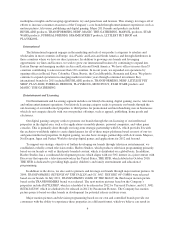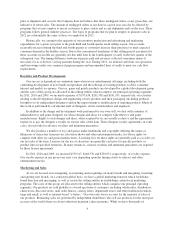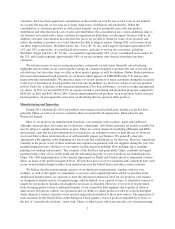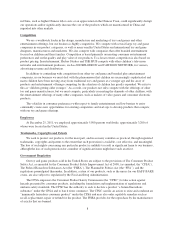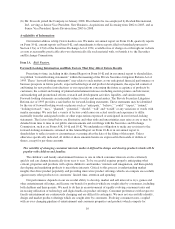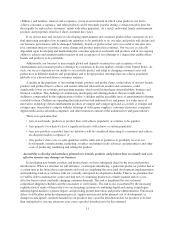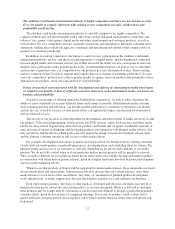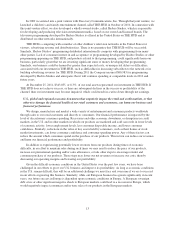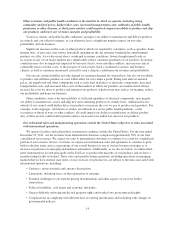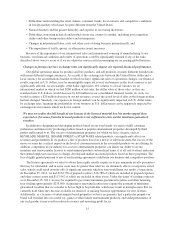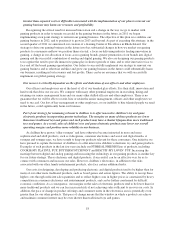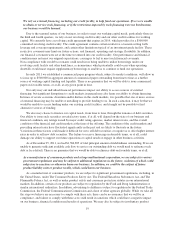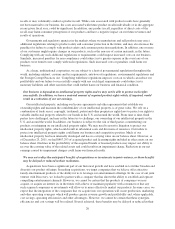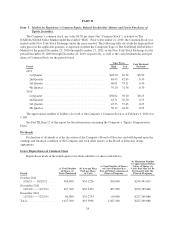Hasbro 2011 Annual Report Download - page 23
Download and view the complete annual report
Please find page 23 of the 2011 Hasbro annual report below. You can navigate through the pages in the report by either clicking on the pages listed below, or by using the keyword search tool below to find specific information within the annual report.Other economic and public health conditions in the markets in which we operate, including rising
commodity and fuel prices, higher labor costs, increased transportation costs, outbreaks of public health
pandemics or other diseases, or third party conduct could negatively impact our ability to produce and ship
our products, and lower our revenues, margins and profitability.
Various economic and public health conditions can impact our ability to manufacture and deliver products
in a timely and cost-effective manner, or can otherwise have a significant negative impact on our sales,
profitability and our business.
Significant increases in the costs of other products which are required by consumers, such as gasoline, home
heating fuels, or groceries, may reduce household spending on the discretionary branded play entertainment
products we offer. As we discussed above, weakened economic conditions, lowered employment levels or
recessions in any of our major markets may significantly reduce consumer purchases of our products. Economic
conditions may also be negatively impacted by terrorist attacks, wars and other conflicts, increases in critical
commodity prices or labor costs, or the prospect of such events. Such a weakened economic and business
climate, as well as consumer uncertainty created by such a climate, could harm our revenues and profitability.
Our success and profitability not only depend on consumer demand for our products, but also on our ability
to produce and sell those products at costs which allow for us to make a profit. Rising fuel and raw material
prices, for paperboard and other components such as resin used in plastics or electronic components, increased
transportation costs, and increased labor costs in the markets in which our products are manufactured all may
increase the costs we incur to produce and transport our products, which in turn may reduce our margins, reduce
our profitability and harm our business.
Other conditions, such as the unavailability of sufficient quantities of electrical components, may impede
our ability to manufacture, source and ship new and continuing products on a timely basis. Additional factors
outside of our control could further delay our products or increase the cost we pay to produce such products. For
example, work stoppages, slowdowns or strikes, an outbreak of a severe public health pandemic, or the
occurrence or threat of wars or other conflicts, all could impact our ability to manufacture or deliver product.
Any of these factors could result in product delays, increased costs and/or lost sales for our products.
Our substantial sales and manufacturing operations outside the United States subject us to risks associated
with international operations.
We operate facilities and sell products in numerous countries outside the United States. For the year ended
December 25, 2011, our net revenues from international customers comprised approximately 50% of our total
consolidated net revenues. We expect our sales to international customers to continue to account for a significant
portion of our revenues. In fact, over time, we expect our international sales and operations to continue to grow
both in absolute terms and as a percentage of our overall business as one of our key business strategies is to
increase our presence in emerging and underserved markets. Additionally, as we discuss below, we utilize third-
party manufacturers located principally in the Far East, to produce the majority of our products, and we have a
manufacturing facility in Ireland. These sales and manufacturing operations, including operations in emerging
markets that we have entered, may enter, or may increase our presence in, are subject to the risks associated with
international operations, including:
• Currency conversion risks and currency fluctuations;
• Limitations, including taxes, on the repatriation of earnings;
• Potential challenges to our transfer pricing determinations and other aspects of our cross border
transactions;
• Political instability, civil unrest and economic instability;
• Greater difficulty enforcing intellectual property rights and weaker laws protecting such rights;
• Complications in complying with different laws in varying jurisdictions and in dealing with changes in
governmental policies;
14


